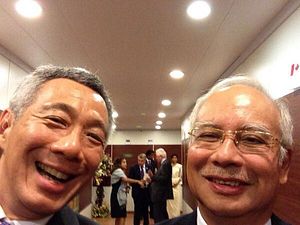Slowly but surely, Southeast Asia’s rail connectivity plans are paving clear tracks across the region. The Singapore-Malaysia High Speed Rail (HSR), the latest addition to the region’s rail blueprint, was formalized at the 7th Malaysia-Singapore Leaders’ Retreat held on Tuesday, in Kuala Lumpur. This is a follow-up to the Memorandum of Understanding signed by both countries earlier in July. First mooted in 2013, the HSR has been billed as a game changer for both countries. Indeed, while there are potential economic dividends from a more connected economy, there are also potential downsides for particular industries.
Though the HSR is expected to change the nature of transport between Singapore and KL, the extent of its impact is very much dependent on ticket prices and the frequency of its services. The HSR will cut travel time between Kuala Lumpur and Singapore to just 90 minutes. Currently, the journey takes anything between 4 and 6 hours by overland coach, and 70 minutes by flight. When transit times are factored in, the HSR is likely to yield time savings of up to 2 hours.
While government officials and businesses have welcomed increased connectivity via the HSR, Low Cost Carriers (LCCs) will likely bear the brunt of this new transport route. The Singapore Changi- KL International Airport route is the third largest international route, largely dominated by Low Cost Carriers. Currently round-trip low cost carrier tickets average SGD 100, while coach tickets are about SGD 28 a trip. Mohd Nur Ismal Mohamed Kamal, Chief Executive of Malaysia’s Land Public Transport Commission was quoted back in 2015 saying that tickets would be less than RM 200 (SGD $74) for a single round-trip. It remains to be seen if existing operators can continue to remain profitable.
The HSR can potentially alleviate air congestion at Singapore’s Changi airport, thus opening up more growth opportunities for the growing aviation hub. According to the Centre for Aviation, Singapore’s Changi airport has been increasingly congested in recent years, with a flight between Changi airport and KLIA taking off every 20 minutes, from 6am to 10 pm. The HSR can potentially reduce the number of flights, thus freeing up precious runway and terminal space to accommodate new airlines and new routes. While this bodes well for Changi Airport’s plans to augment its lead as an aviation hub, direct connectivity between Singapore and Malaysia could also increase competition between the two hubs that serve a similar pool of passengers transiting in Southeast Asia.
Furthermore, if the effects of other HSR projects around the world (e.g Tokyo-Osaka, London Paris) are anything to go by, the easy commute will serve to further integrate the KL and Singapore economies, bringing about further growth opportunities for both countries. In particular, the HSR is bookended by Jurong East in Singapore and Bandar Malaysia, areas that have been earmarked by respective governments as the second Central Business Districts for their countries.
Nevertheless, the Singapore-Malaysia High Speed Rail is more than just economics. It is a major step in the advancement of bilateral ties between the two countries. Fierce competition between China and Japan to build the railway has transformed it into a platform for major power rivalries in the region.
Actual construction of the HSR is expected to start in 2018, with trains up and running by 2026. Until then, the Singapore-Malaysia HSR will be closely monitored by both political and economic observers alike.

































